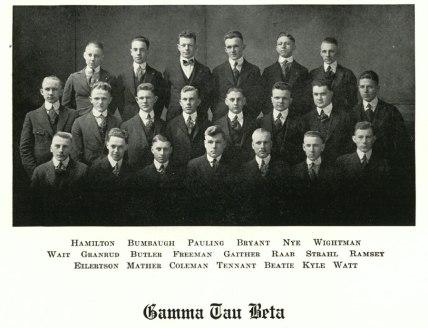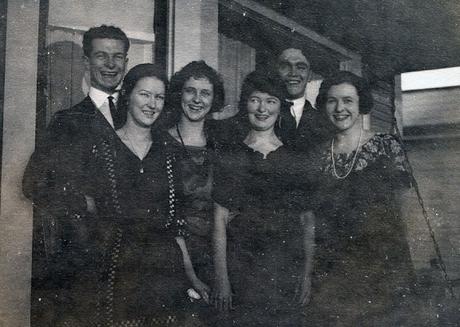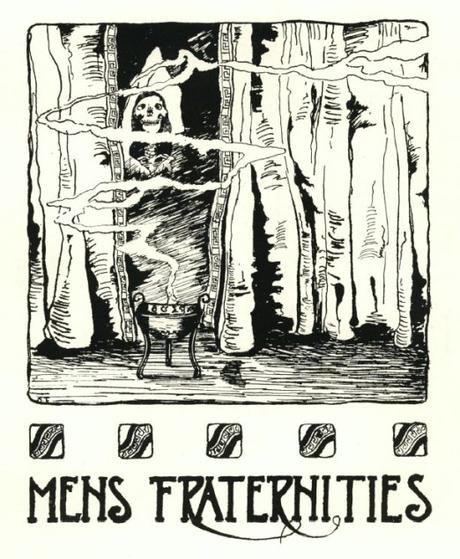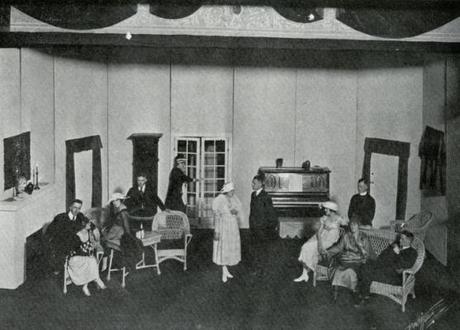
[An examination of Linus Pauling’s sophomore year at Oregon Agricultural College, which began in Fall 1918. This is part 3 of 3.]
Life on the Oregon Agricultural College campus during Linus Pauling’s sophomore year started off with one primary focus: World War I. As a result, Greek life activities and other traditional social excursions were temporarily suspended by the U.S. War Department as their ideals were deemed to be “incompatible” with those espoused by programs like the Student Army Training Corps. Ever vigilant, OAC students found their way around some of these restrictions by participating in planned informal gatherings. Greek life was not reinstated until late fall, after the war’s conclusion, and social planning committees did not return until late winter term.
Despite the war pulling away many of the school’s athletes for service, OAC still fielded teams through all three terms. Sports offered students a distraction from the realities of war and gave them a common point of focus to rally behind. In fall, football games began shortly after school started with the first contest of the season taking place on Saturday, October 12, 1918. As the term moved forward, several games were cancelled on account of the influenza epidemic and the season ended on a disappointing note with a 13-6 Civil War loss to Oregon in Eugene. Illness hampered the basketball team as well and their schedule on a down note with two additional losses to the rival Ducks, described as the “Lemon Yellow men” in the class yearbook.
Women’s athletics were also popular on the OAC campus. Though the war effort led to the cancellation of the the hockey and tennis seasons, OAC’s ladies completed intercollegiately in swimming and intramurally in basketball and soccer. Nearly 300 students turned out to participate in basketball, the women’s sport with the longest history at OAC.

Linus Pauling and Paul Emmett (back row) with a group including Pauling’s sisters Lucile (3rd from left) and Pauline (far right), 1919. Paul Emmett and Pauline Pauling married some fifty-seven years after this photo was taken.
After living on campus during his freshman year, Pauling spent the fall 1918 term rooming with Lloyd Jeffress, a friend from his childhood who had first introduced him to the chemistry a few years back. In addition to this crucially important experience, it was through Jeffress that Pauling also met Paul Emmett, a fellow OAC student who would become a close friend, research partner and, eventually, brother-in-law.
Just as Pauling had been academically successful in his freshman year, so too did he excel in the classroom during his sophomore year. Taking courses including engineering physics, metallurgy, analytical chemistry, and mining engineering, Pauling received all A’s in his math and science classes throughout the year, and a complete 4.0 grade point average in his winter term. In addition to his schoolwork, Pauling was a member of the Miner’s Club. This group took field trips to study mine surveying, mining geology, and mining methods throughout the year. These excursions were particularly fascinating to Pauling as he had already been interested in rocks and minerals for many years.
The OAC student body was a very vocal bunch who often took to their school newspaper, The Barometer, to voice their opinion. One particular issue of common concern was the fight to resume programmatic social functions. Temporarily banned during the war, activities of this sort still had not been reinstated by the beginning of the winter 1919 academic term.
In response to growing unrest, college administrators created a social events committee, comprised solely of faculty members, to which the students offered their complaints. As a result of this dialogue, the first school-sponsored social function of the year – aside from a series of Armistice celebrations – was a “Greater O.A.C.” dance held on Saturday, February 1, 1919.

Illustration included in the 1918-1919 Beaver yearbook.
In the spring, an exciting and important opportunity was extended to Pauling: an offer to join the Gamma Tau Beta fraternity. Pauling eagerly pledged, despite being troubled by the feeling that he had been selected mostly to raise the house grade point average. By 1919, OAC’s Greeks had established a reputation of regularly compiling a collective GPA that was higher than the college average, and Pauling suspected that his invitation may have been in keeping with the continuation of this ambition.
Pauling’s experience in the fraternity was different than anything he had known before. His upper-class house brothers nicknamed him “Peanie” and expected that he, as with his fellow underclassmen, would go out on weekly dates. Pauling was not interested in pursuing this obligation and often feigned illness as a means to excuse himself. Indeed, romantic involvements were mostly a passing afterthought for Pauling in the years prior to his meeting Ava Helen Miller in January 1922.
By the end of spring term, there were at least 25 fraternities and 13 sororities associated with Oregon Agricultural College. Not surprisingly, Greek life on campus was a potent force, and was especially prevalent within the spheres of intramural sports and competitive speech. Gamma Tau Beta regularly competed in both areas and often fared well – in 1919 the house placed second in baseball and track, and third in basketball.
In debate, students from across campus enjoyed taking on topics both serious and comedic. In one instance, competitors were asked to wrestle with the following argument: “Resolved, That an alligator is a better pet than a rhinoceros.” Pauling participated in an inter-class competition that spring and eventually developed a reputation for his oratorical skill.

Image of the “Nothing But The Truth” cast, 1919
Indeed, once unshackled from the restrictions of war-time, social life took off during spring term. In April, the college’s theater club, Mask and Dagger, performed a farce titled “Nothing but the Truth.” A “stunt show” put on by students throughout campus was also staged during the term. And in addition to the inter-class debate competition, Pauling also participated in a sophomore class party to round out the school year.
Athletically, while fall and winter proved pretty rough, spring brought a couple of OAC victories over rival Oregon in both track and baseball. These wins contributed to a broader sense of good feeling on a campus that had seen some tough times over the past academic year.
Buoyed alongside his classmates was young Linus Pauling. Still just 18 years old, Pauling concluded his sophomore year with excellent grades, an improved social standing through his fraternity, and a job lined up over the summer to test paving materials used on Oregon’s brand new highways.
